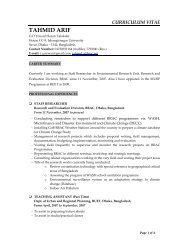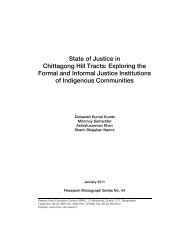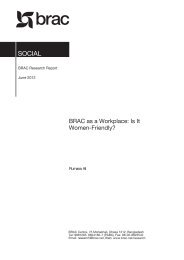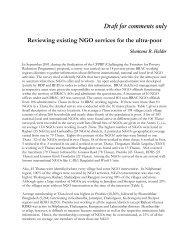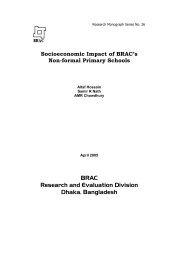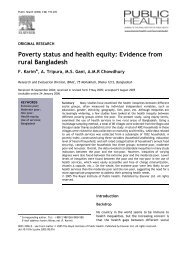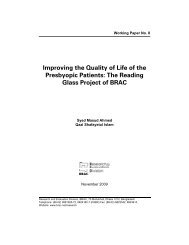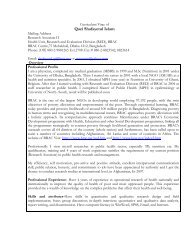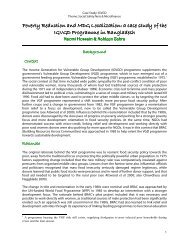Combining health and social protection measures to reach the ultra ...
Combining health and social protection measures to reach the ultra ...
Combining health and social protection measures to reach the ultra ...
You also want an ePaper? Increase the reach of your titles
YUMPU automatically turns print PDFs into web optimized ePapers that Google loves.
Decision-making<br />
was prior <strong>to</strong> 2001, a time series of annual life tables<br />
(adjusted if <strong>the</strong> registration level was incomplete) between<br />
1985 <strong>and</strong> <strong>the</strong> latest available year was used <strong>to</strong> project<br />
levels of child <strong>and</strong> adult mortality for 2001. For small<br />
countries with populations of less than 500 000, moving<br />
averages were used <strong>to</strong> smooth <strong>the</strong> time series. Projected<br />
values of child <strong>and</strong> adult mortality were <strong>the</strong>n applied <strong>to</strong> a<br />
modified logit life table model 6 , using <strong>the</strong> most recent<br />
national data as <strong>the</strong> st<strong>and</strong>ard, <strong>to</strong> predict <strong>the</strong> full life table<br />
for 2001, <strong>and</strong> HIV/AIDS <strong>and</strong> war deaths were added <strong>to</strong><br />
<strong>to</strong>tal mortality rates for 2001 where necessary. This<br />
method was applied for 40 countries using a <strong>to</strong>tal of 711<br />
country-years of death registration data.<br />
✜ Countries with o<strong>the</strong>r information on levels of child <strong>and</strong><br />
adult mortality. For 37 countries, estimated levels of<br />
child <strong>and</strong> adult mortality were applied <strong>to</strong> a modified logit<br />
life table model 6 , using a global st<strong>and</strong>ard, <strong>to</strong> estimate <strong>the</strong><br />
full life table for 2001, <strong>and</strong> HIV/AIDS deaths <strong>and</strong> war<br />
deaths were added <strong>to</strong> <strong>to</strong>tal mortality rates as necessary.<br />
For most of <strong>the</strong>se countries, data on levels of adult<br />
mortality were obtained from death registration data,<br />
official life tables, or mortality information derived from<br />
o<strong>the</strong>r sources such as censuses <strong>and</strong> surveys. The allcause<br />
mortality envelope for China was derived from a<br />
time series analysis of deaths for every household in<br />
China reported in <strong>the</strong> 1982, 1990, <strong>and</strong> 2000 censuses.<br />
The extent of underreporting of deaths in <strong>the</strong> 2000<br />
census was estimated at about 11.3% for males <strong>and</strong><br />
18.1% for females 1 . The all-cause mortality envelope for<br />
India was derived from a time series analysis of agespecific<br />
death rates from <strong>the</strong> sample registration system<br />
after correction for underregistration (88%<br />
completeness) 8 .<br />
✜ Countries with information on levels of child mortality<br />
only. For 55 countries, 42 of <strong>the</strong>m in sub-Saharan<br />
Africa, no information was available on levels of adult<br />
mortality. Based on <strong>the</strong> predicted level of child mortality<br />
in 2001, <strong>the</strong> most likely corresponding level of adult<br />
mortality (excluding HIV/AIDS deaths where necessary)<br />
was selected, along with uncertainty ranges, based on<br />
regression models of child versus adult mortality as<br />
observed in a set of almost 2000 life tables judged <strong>to</strong> be<br />
of good quality 2,6 . These estimated levels of child <strong>and</strong><br />
adult mortality were <strong>the</strong>n applied <strong>to</strong> a modified logit life<br />
table model, using a global st<strong>and</strong>ard, <strong>to</strong> estimate <strong>the</strong> full<br />
life table in 2001, <strong>and</strong> HIV/AIDS deaths <strong>and</strong> war deaths<br />
were added <strong>to</strong> <strong>to</strong>tal mortality rates as necessary.<br />
Evidence on adult mortality in sub-Saharan African<br />
countries remains limited, even in areas with successful<br />
child <strong>and</strong> maternal mortality surveys.<br />
Classification of causes of disease <strong>and</strong> injury<br />
Disease <strong>and</strong> injury causes of death <strong>and</strong> of burden of disease<br />
were classified using <strong>the</strong> same tree structure as in <strong>the</strong> original<br />
GBD study 7 . The first level of disaggregation comprises <strong>the</strong><br />
following three broad cause groups:<br />
✜ Group I: communicable, maternal, perinatal, <strong>and</strong><br />
nutritional conditions;<br />
✜ Group II: noncommunicable diseases;<br />
✜ Group III: injuries.<br />
Each group was <strong>the</strong>n divided in<strong>to</strong> major cause<br />
subcategories, for example, cardiovascular disease (CVD) <strong>and</strong><br />
malignant neoplasms (cancers) are two major cause<br />
subcategories of Group II. Beyond this level, two fur<strong>the</strong>r<br />
disaggregation levels were used, resulting in a complete<br />
cause list of 135 categories of specific diseases <strong>and</strong> injuries.<br />
Group I causes of death consist of <strong>the</strong> cluster of conditions<br />
that typically decline at a faster pace than all-cause mortality<br />
during <strong>the</strong> epidemiological transition. In high-mortality<br />
populations, Group I dominates <strong>the</strong> cause of death pattern,<br />
whereas in low-mortality populations, Group I accounts for<br />
only a small proportion of deaths. The major cause<br />
subcategories are closely based on <strong>the</strong> ICD chapters with a<br />
few significant differences. Whereas <strong>the</strong> ICD classifies chronic<br />
respira<strong>to</strong>ry diseases <strong>and</strong> acute respira<strong>to</strong>ry infections in<strong>to</strong> <strong>the</strong><br />
same chapter, <strong>the</strong> GBD cause classification includes acute<br />
respira<strong>to</strong>ry infections in Group I <strong>and</strong> chronic respira<strong>to</strong>ry<br />
diseases in Group II. Note also that <strong>the</strong> Group I subcategory<br />
of “causes arising in <strong>the</strong> perinatal period” relates <strong>to</strong> <strong>the</strong><br />
causes included in <strong>the</strong> corresponding ICD chapter, principally<br />
low birth weight, prematurity, birth asphyxia, <strong>and</strong> birth<br />
trauma, but does not include all causes of deaths occurring<br />
during <strong>the</strong> perinatal period, such as infections, congenital<br />
malformations, <strong>and</strong> injuries. In addition, <strong>the</strong> GBD includes<br />
only deaths among children born alive <strong>and</strong> does not<br />
estimate stillbirths.<br />
The GBD classification system does not include <strong>the</strong> ICD<br />
category “Symp<strong>to</strong>ms, signs, <strong>and</strong> ill-defined conditions” as one<br />
of <strong>the</strong> major causes of deaths. The GBD classification scheme<br />
has reassigned deaths assigned <strong>to</strong> this ICD category, as well<br />
as some o<strong>the</strong>r codes used for ill-defined conditions, <strong>to</strong><br />
specific causes of death. This is important from <strong>the</strong><br />
perspective of generating useful information <strong>to</strong> compare<br />
cause of death patterns or <strong>to</strong> inform <strong>health</strong> policy-making,<br />
because it allows unbiased comparisons of cause of death<br />
patterns across countries or regions.<br />
Deaths are categorically attributed <strong>to</strong> one underlying cause<br />
using ICD rules <strong>and</strong> conventions. In some cases where <strong>the</strong><br />
ICD rules are ambiguous, <strong>the</strong> GBD 2001 follows <strong>the</strong><br />
conventions used by <strong>the</strong> GBD 1990 study 7 . It should also be<br />
noted that a number of causes of death act as risk fac<strong>to</strong>rs for<br />
o<strong>the</strong>r diseases. Total mortality attributable <strong>to</strong> such causes<br />
may be substantially larger than <strong>the</strong> mortality estimates for<br />
<strong>the</strong> cause in terms of ICD rules for underlying causes. For<br />
example, <strong>the</strong> GBD 2001 estimates that 960 000 deaths were<br />
due <strong>to</strong> diabetes mellitus as an underlying cause, but when<br />
deaths from CVD <strong>and</strong> renal failure attributable <strong>to</strong> diabetes are<br />
included, <strong>the</strong> global <strong>to</strong>tal of attributable deaths rises <strong>to</strong> almost<br />
3 million 9 . O<strong>the</strong>r causes for which important components of<br />
attributable mortality are included elsewhere in <strong>the</strong> GBD<br />
cause list include hepatitis B or C (attributable liver cancer<br />
<strong>and</strong> renal failure), unipolar or bipolar depressive disorders<br />
<strong>and</strong> schizophrenia (attributable suicide), <strong>and</strong> blindness<br />
(mortality attributable <strong>to</strong> blindness whe<strong>the</strong>r from infectious or<br />
non-infectious causes).<br />
164 ✜ Global Forum Update on Research for Health Volume 4




